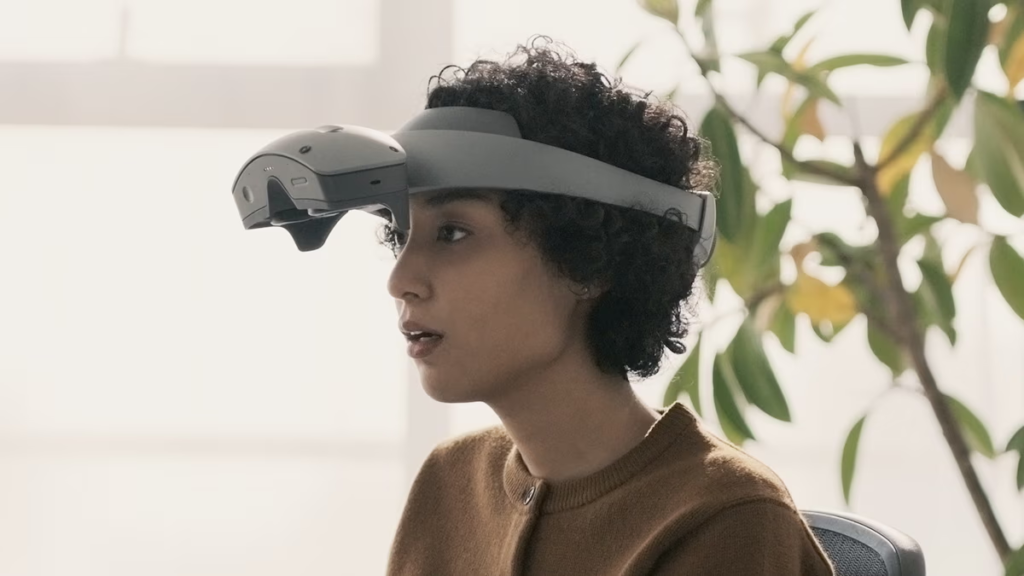
Sony has always been a pioneer in the field of immersive technology, and its latest product is no exception. At the Consumer Electronics Show (CES) 2024, the company revealed a new head-mounted display that combines virtual and augmented reality in a sleek and powerful device. The headset, which has not been given an official name yet, is aimed at professionals and creatives who want to work on and view 3D projects, applications, and models. Here are some of the features that make it stand out from the crowd.
Specs
The headset boasts two 4K OLED microdisplays, one for each eye, that deliver a sharp and vivid image quality. The resolution is higher than most of the current VR headsets on the market, such as the PlayStation VR 2 and the Meta Quest 3, and only slightly lower than the Apple Vision Pro 2, which offers a little over 4K per eye. The high pixel density reduces the screen-door effect and enhances the sense of presence and immersion.
The device is also powered by a Qualcomm XR2 Plus Gen 2 processor, a new and improved version of the chip that runs the Quest 3. This means that the headset can handle complex and demanding tasks without relying on an external computer or console. However, it still falls behind the Apple Vision Pro 2, which uses the M2 processor, a custom-made chip that is more efficient and faster than the Qualcomm one.
Design
The headset has a sleek and futuristic design, with a black and silver color scheme and a curved visor. It has six cameras built into the front, which provide video see-through or passthrough functionality. This allows the user to see the real world through the headset, and overlay digital content on top of it, creating a mixed or augmented reality experience. The headset can also switch to a fully virtual reality mode, blocking out the external environment.
One of the most convenient features of the headset is the flip-up mechanism, which lets the user lift the visor without taking off the whole device. This is useful for professionals and creatives who need to switch between the virtual and the real world frequently, or who want to interact with other people without losing eye contact. The flip-up design also makes the headset more comfortable and less claustrophobic than other devices that cover the entire face.
The headset is not meant for gaming, but rather for productivity and creativity. It is more similar to the Microsoft HoloLens 2, which is also a mixed reality device that targets enterprise and industrial customers. However, the Sony headset has a wider field of view and a higher resolution than the HoloLens 2, making it more suitable for viewing and manipulating 3D content.
Controllers
The headset comes with two different controllers, each with a distinct function and shape. One controller is mainly for pointing and selecting, and it looks like a more futuristic version of the typical VR wands. It has a trigger, a touchpad, and a few buttons, and it fits comfortably in the hand. The other controller is for manipulating objects, and it resembles a ring that wraps around the palm. It has a pressure sensor and a haptic feedback system, and it allows the user to grab, move, rotate, and scale virtual objects with natural gestures.
The controllers are different from the usual wands that most VR headsets use, and they offer a more intuitive and realistic way of interacting with the virtual environment. The pointing controller is similar to a laser pointer, and it can be used to select menus, icons, and tools. The ring controller is similar to a glove, and it can be used to manipulate objects as if they were real. The combination of the two controllers gives the user more control and flexibility over their actions.
Conclusion
Sony’s mixed reality headset is a remarkable device that showcases the company’s innovation and vision. It has impressive specs, a slick design, and unique controllers that make it one of the most advanced and versatile headsets in the world. It is not a consumer product, but rather a professional and creative tool that can be used for various applications, such as architecture, engineering, education, art, and entertainment.
The headset is expected to be available later in 2024, but the price has not been announced yet. It is likely to be expensive, given its high-end features and target market. However, for those who are looking for a cutting-edge device that can blend the virtual and the real world in a seamless and immersive way, Sony’s mixed reality headset may be worth the investment.
What do you think of Sony’s mixed reality headset? Do you think it will revolutionize the XR industry? Let us know in the comments below.